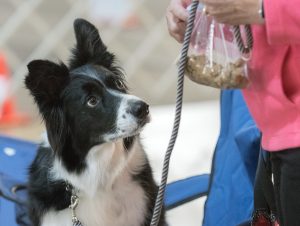The first time it was suggested that my dog’s lack of understanding about delayed reinforcement might be contributing to her ring stress, I was skeptical. “She just needs more energy and excitement. I need to build her drive and focus,” I thought. But as things worsened, I took a step back and began learning more about the importance of delayed reinforcement. My skepticism morphed into whole-hearted belief and I began a process of teaching my dog understand this powerful concept.
So what is this magical idea that helped me get back in the ring all about?
Delayed Reinforcement in Agility
Put simply, this concept refers to a time delay between when our dogs perform the desired behavior and the delivery of the reward. In agility, delayed reinforcement looks like this: dog completes the course and then receives food or a toy outside the ring. Usually there is a delay of about 30 seconds to a minute from the beginning of their performance and the delivery of the reward.
Training vs. Trialing
In training, food and toys are readily available for our dogs. They happen inside the ring. The frequency of the rewards is usually high. And the food or toy is typically in our pocket, tossed by our instructor or pre-placed on the course. There is nothing wrong with this. We should absolutely be rewarding our dogs – it’s how learning happens – especially as they are building new skills and as we make things harder for them.
In trials, rewards are not permitted to be carried on your body or to be given inside the ring (at least in the United States). It’s easy for us as handlers to go from rewards to no rewards, but this can be very hard for our dogs.

The way we train creates predictability and expectation of a reward. Dog does weave poles correctly, ball is thrown. They send to a tunnel, cheese appears on the turf. Dog does the full course, cookie party happens after the last jump. Again, this is a good thing, it’s how our dogs learn. So if we abruptly withhold rewards inside the ring at a trial after being such reliable reward dispensers in class, our dogs will likely feel confused or frustrated.
“I did all the things you asked for, now where is my reward?”
“You always give me treats in the ring, but now you’re not and it’s not fun.”
How Lack of Delayed Reinforcement Training Impacted My Dog
Some dogs will figure this change out on their own and it won’t create too much of an issue. But for a lot of dogs, the confusion and frustration that comes from withheld rewards can start to affect their performance.
As an agility newbie, I had no idea that I needed to teach delayed reinforcement or what could happen if I didn’t. My first trial was the first time my dog, Ruby, didn’t get a reward in the ring. Looking back, that makes me cringe. I remember her looking at me after she came out of the last tunnel with a look of expectation. I put on her leash, exited the ring and jogged over to our container of meatballs. She was a good sport about it, but even in my unawareness, I could see she didn’t understand what was going on or where the reward was. This worked for our first several trials, but then some issues began to arise.
In my experience with Ruby, the impact of not teaching her about delayed reinforcement was shutting down in the ring. Sniffing on the startline. Not releasing off the startline. Trotting instead of running. Refusing obstacles. And often speeding up at the very end when she knew the reward was coming soon. She came to understand that at trials, she wouldn’t be getting paid in the ring like in training and her behavior made it clear she was stressed and uninterested.
Other Signs of Fallout
Dogs may also respond in other ways. They may leave the ring. Hide in a tunnel. Run off and do their own thing. Repeat a favorite obstacle three times. Jump on or bite the handler. Stop running. Play a game of “catch me if you can” at the end of the run. Go say hi to the ring crew.
Or it could be less dramatic. Perhaps they just aren’t quite as fast. They’re moving, but not as enthusiastic.
These are all ways our dogs respond to the lack of clarity we create when we don’t bridge the gap between training and trials by teaching delayed reinforcement.
The Benefits
On the flip side, when our dogs do have clarity about when and where they’ll receive reinforcement, their performance isn’t impeded by that confusion and frustration. Questions about the reward aren’t creating conflict in their brains. They can focus on the task at hand, knowing where the reward is located, which results in confidence and enthusiasm. I have experienced this with my own dog.
I hope you have an understanding about what delayed reinforcement is and how it can supercharge your dog’s performance in the ring. Check out part 2 of this post to learn about the step-by-step process I used to teach my dog about delayed reinforcement here.





